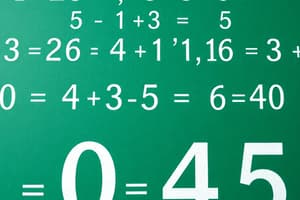Podcast
Questions and Answers
What is the result of $7 + 9$?
What is the result of $7 + 9$?
- 15
- 14
- 16 (correct)
- 17
How is subtraction of whole numbers performed?
How is subtraction of whole numbers performed?
- By dividing the numbers
- By aligning digits in columns and comparing tens and ones places separately (correct)
- By multiplying the numbers together
- By adding the numbers
When performing subtraction, what should you do if you need to borrow from a higher place value?
When performing subtraction, what should you do if you need to borrow from a higher place value?
- Leave the calculation incomplete
- Move up a unit from the hundreds column
- Ignore the need to borrow
- Move down a unit from the hundreds column and increase its corresponding digit by 10 (correct)
What is the result of multiplying $5 \times 6$?
What is the result of multiplying $5 \times 6$?
Which property states that whole numbers are closed under multiplication and addition?
Which property states that whole numbers are closed under multiplication and addition?
Which property of whole numbers involves the order relationships like trichotomy and antisymmetry?
Which property of whole numbers involves the order relationships like trichotomy and antisymmetry?
What is the definition of a whole number?
What is the definition of a whole number?
When adding whole numbers, where do you start lining up the digits?
When adding whole numbers, where do you start lining up the digits?
What should you do if the ones column in addition contains nine or more units?
What should you do if the ones column in addition contains nine or more units?
Which of the following is an essential property of whole numbers for problem solving?
Which of the following is an essential property of whole numbers for problem solving?
What is excluded from whole numbers based on the given text?
What is excluded from whole numbers based on the given text?
Which arithmetic operation involves combining two sets of identical objects?
Which arithmetic operation involves combining two sets of identical objects?
Flashcards are hidden until you start studying
Study Notes
Whole Numbers: A Foundational Guide to Addition, Subtraction, Multiplication, and Properties
Whole numbers form the building blocks of mathematics, laying a solid foundation upon which more complex concepts can grow. In this guide, we'll explore whole numbers from their basic definition through important operations like addition, subtraction, and multiplication, while also touching upon essential properties that make them so useful for problem solving.
Definition of Whole Numbers
A whole number is any nonnegative integer, including zero itself – ( 0 ), ( 1 ), ( 2 ), ( -1 ) (yes, it is technically a whole number!) isn't included since it has a negative sign. These positive integers have been used by humans to represent quantities since ancient times. Negative whole numbers don't fall within our current scope, but they will become relevant when discussing arithmetic with signed numbers later.
Arithmetic Operations
Addition
Adding whole numbers involves combining two sets of identical objects—for example, apples or marbles. To perform addition, line up the digits from left to right, starting with the ones column. If that column contains nine or more units, carry over one ten into the next column to the left. Continue this process until reaching the most significant digit (the thousands column if working with three-digit numbers). Finally, combine each digit pair based on place value to obtain the sum.
For instance, let's calculate (7 + 9):
7 (+) 9 = 16
------+-----
8 (carry)
16
Subtraction
Subtracting whole numbers means taking away from one set of objects another set of equal objects. To perform subtraction, align the digits of both numbers in columns just as you would during addition, comparing the tens and ones places separately. If needed, borrow from higher place values following specific rules. For example, move down a unit from the hundreds column and increase its corresponding digit by 10 before performing the tens operation.
Let's find out [25 - 13] :
25 (-) 13 = 12
-------+------
2 (borrowed 10 from hundreds column)
12
Multiplication
Multiplying whole numbers corresponds to arranging groups of identical items multiple times, finding how many total items result from these arrangements. To multiply two whole numbers, start by writing the first factor below the second, aligned horizontally. Then, draw lines connecting the top row and the bottom row vertically where each factor appears together. Multiply digit pairs according to place value and collect sundry results.
Here's what happens when we multiply (5 \times 6):
5 x 6
---- ---
| 5 | * 6 | = 30
|____|=====|
3 0
+---+--+
6
-----
36
Properties of Whole Numbers
Understanding the fundamental properties of whole numbers allows us to simplify calculations and solve problems more effectively. Some key properties include closure under addition and multiplication, commutativity, associativity, distributivity, identity elements, inverse elements, and order properties such as trichotomy, transitivity, antisymmetry, and reflexivity. Exploring these properties gives us powerful tools to handle real-world scenarios involving various combinations of whole numbers.
In summary, understanding whole numbers and their associated operations helps build strong mathematical foundations, opening doors towards mastery of more advanced topics. By exploring each concept covered here with patience and practice, learners gain confidence in using whole numbers efficiently, accurately, and creatively.
Studying That Suits You
Use AI to generate personalized quizzes and flashcards to suit your learning preferences.




